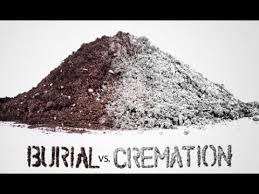A decade ago I read an article in a popular magazine that showed aerial pictures of burial grounds around the western world, mostly in remote areas, to drive home the point that in the Internet-less and telephone-less world of the yore, people all over the world somehow stuck to a similar pattern of keeping the zone for dead people separate from the living. Reasons ranged from sacred (respect) to scared (disease, illusions) it supposed.
Nihilists would ask "the whole world is a burial ground anyway, why bother?"
I am not a nihilist. My drift is different.
In Hinduism, fire plays a significant role though there are many interpretations. Whatever is offered in the fire goes to gods directly.
Fire releases the soul from the body and returns the body to the five elements by which it was made. And so on.
In Hinduism, the shortest way for a departed soul to reach heavens is riding piggyback on fire. Fire rises from ground to sky and so the soul has to go up...
It was a practical aspect too, otherwise the dead would swamp the world in no time and we all would tread with the stigma of having to step on so many dead bodies buried under our footprint! The fainter ones at heart among us would have to deal with the scare quotient of the 'revenge of ghosts' that we trampled!
Saints were exceptions; A great saint typically announces in advance, the day he would leave his/her body. Disciples would then construct a structure around the body, kind of burying it. Folk wisdom ranged from the saints resurrecting themselves at will to saints not have to be burned as they already burnt their mortal remains in the fire of wisdom...
World over, this seemed to have been the preferred way of handling the dead. That is, still the advent of Christianity.
Maybe to differentiate itself from Hinduism and all other religions at that point in time including pagan practises which were loosely based on Hinduism, Christianity insisted that the dead must be buried and codified the same in its religious text highlighting the reason (Genesis 3:19 “By the sweat of your face you shall eat bread, till you return to the ground, for out of it you were taken; for you are dust, and to dust you shall return.”)
As if codification was not enough, Jesus was buried after Crucifixion and resurrected on the third day thereby showing the possibility that existed (that all buried would resurrect on judgement day) when buried vs cremated.
Even as if this was not enough, Mufasa imparted to young Simba the classic wisdom of ages in a simple sentence "When we die, our bodies become the grass, and the antelope eat the grass. And so we are all connected in the great Circle of Life. "
As Christianity spread, burial practice also spread all over the world, even in India. Unlike Christianity which forbade cremation, Hinduism did not ban dead from getting buried.
Due to rapid urbanization, living quarters all over the western world grew rapidly in the last few hundred years and people had to solve the problem of 'moving the dead zones' constantly to the edge of living zones. Needless to say, the problem was compounded by the same folks who were trying to solve it; rate of birth pipped rate of death hands down!
Many cemeteries became parks, residential space, commercial space (and what not) etc... in the reclassified zones while newer ones were marked at the edge of life zones.
As space became scarce and population kept growing, groups here and there in the western world started resuming burial as a practical solution as well as a symbolic revolt against the church. Cat and Mouse games ensued for hundreds of years between churches (and governments as extensions) and these groups - bans, prosecutions, revocations, casting out etc...Reluctantly the Church gave in and burial came back with force, thereby liberating the land!
(Islam also forbids cremation reasoning that we must treat dead similar to living and hence no burning, though it makes an exception for infectious diseases spread by burying en mass due to epidemics, they cremate them after carefully verifying the evidence of the same.)
While Hinduism continues the fire ritual without diluting the sacredness of the ritual as well as the ashes for millennia, western world quickly moved on and started using the bye-product of the cremation act (ashes) in The Good (scattering ashes/burying the urn with ashes underneath trees and naming the trees after the departed ones), The Bad (encapsulating the ashes in jewellery) and The Ugly ways (feeding ashes to 'game animals' through salt licks, hunting them later on and eating their meet digested with the ashes, using the ash in nail polish, yes!).
In India, we do have burial grounds still but probably due to the foreseeing ability of our people, we did not redefine the dead zone but instead grew our living zone around it knowing for sure that at some point in time the burial ground would become prime property.
I had the misfortune of visiting such a burial ground recently. This one is nestled amidst a densely populated area within city limits. Out of what I saw, two things struck me;
1. there was a steel trading shop abutting the burial ground.
2. A couple of burial plots had flags fluttering above them, not
national flags but local political flags. I just couldn't figure this
out!
 |
| Carry it beyond! |

Hinduism ideology: Body made of five elements (panchabootha). After our soul leaves the body, cremation is the best process to separate the panchabootha quickly and returnback to their original forms.
ReplyDelete